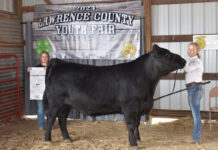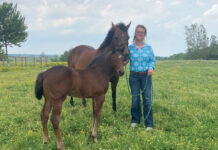
Many farmers with all size operations, from small to large, have appreciated the grazing school program conducted by National Resource Conservation Service (NRCS) and Missouri Department of Natural Resources (DNR) throughout various Ozarks communities but perhaps none more than Kenneth Parsons of Webster County. After attending his first grazing school nearly 10 years ago, he and his wife, Mary Ann have offered their 150-acre farm as a demonstration and classroom site for several grazing schools. Located half way between Marshfield and Northview, Mo., the Parsons have welcomed farmers from all over the Ozarks to come, share and learn how to grow better grass and most of all, make better use of the grass they have.
“One year it rained on us and we just all trooped into the barn to continue the class,” Kenneth explained. “During the 2005 class, I had a concrete well house to be installed and I told the guy, I want it delivered here and installed at exactly 1:30 that day. If you’re late, I don’t want it at all, and by golly, they got it here. And the whole class got to see exactly how it was done.
“We’ve plugged three old wells on our property here over the years for safety reasons of course, but you do it according to their specifications and the agencies involved will help pay for that. Meanwhile, we have eight ponds on our place and we have one fenced off to the cattle completely, as it is a spring fed pond. I’ve put in 3,500 feet of water pipe and 3,500 feet of electric fencing over the years now, little by little, doing it all myself. Three of my ponds are in fields with no electric but it doesn’t matter. Once those cows get used to that electric fencing, I can just use a heavy string across those other fields and they never bother it.”
Kenneth continued enthusiastically. “We have a total of 16 paddocks and I try to move my cows, every three to four days, depending on grass growth. They like for you to have 3 inches of grass but during drought, that’s not always so easy. I usually keep around 30 head, although right now I’ve got 23 cows, 17 calves and four left from last year. Almost all are Limousin although I have a couple Black Angus, three Red Angus and a Red Angus bull who I swear, thinks he’s a dog,” he added with a laugh.
“We have a combination of grasses, some fescue, orchardgrass, clover, bluestem, lespedeza and Timothy. I usually try to reseed with clover in a different field each year. Of course, we soil test and fertilize each year although I’ve been a little hesitant to apply the fertilizer right now, waiting on rain.
“I think the rotational grazing really helps with the parasite control, especially the flies. Our animals are all grass fed plus minerals and a little hay. We use cubes when it gets bad, like too dry. Rotational grazing really helps with the hay usage as well.”
While Kenneth Parsons finds that rotational grazing has tremendous advantages, he really could not think of any disadvantages. “The cows get used to it quickly and move easily from paddock to paddock. I just use my little Mule (utility terrain vehicle) to move them. The rotational grazing is one of the best things that has ever happened to small farmers like me.”
Kenneth has also appreciated in programs like the Conservation Practice 22 (Riparian Corridor Buffers), which keeps cattle out of streams and encourages planting of trees along natural waterways. This helps to stabilize banks and improve shading of streams and thus improves water quality. “We planted 1,000 trees, red bud, dogwood and oaks, 12 feet apart along 1.6 acres of stream bank. I’ve also used the Conservation Stewardship Program, in which you recycle your oil, monitor and take good care of your pastures. It all adds up so I would highly recommend it all,” he concluded.







